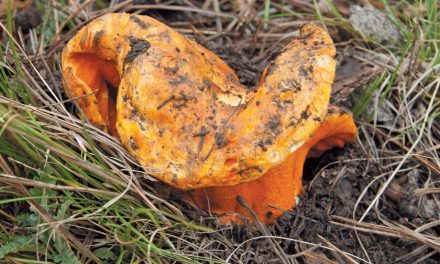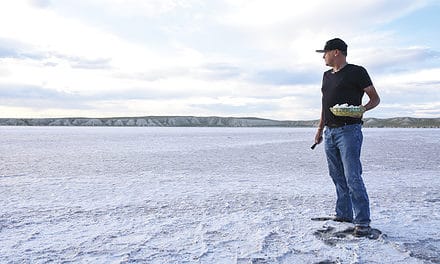By Susan DeFreitas | Photos by Stephanie Cameron

Composting operation at Reunity Resources.
Here in New Mexico, our soils tend to be desertified, lacking the organic matter and microbes that nurture plant life. Conventional agriculture and ranching contribute to this issue, and the hotter, drier conditions associated with climate change will only continue to make it worse. But just as human activity has helped to strip fertility from the soil, human activity can help to restore it—and in this, New Mexico is leading the way with innovative efforts ranging from the grassroots to the state level.
One organization working to build soil across the state is Santa Fe’s Reunity Resources. Founded in 2011, this nonprofit started off by turning used fryer grease from local restaurants into biodiesel fuel. It quickly grew to embrace composting, fulfilling its mission to help to divert waste from local landfills.
In 2012, Reunity made a proposal to the City of Santa Fe’s director of solid waste to pick up food scraps from local restaurants—a proposal that was “professionally and politely” declined. But the city worked with Reunity to develop a pilot program for this service, and when the pilot proved successful, the program continued to grow, eventually including the food scraps from Santa Fe Public Schools. In time, all that food waste gave rise to Reunity’s compost sales to the community, which local gardeners have enjoyed since 2015.
In this way, Reunity has played a very real part not only in keeping local food waste out of landfills—where it creates methane, a potent greenhouse gas—but in enriching local soils.
But then the pandemic hit—restaurants were all but shuttered, and kids weren’t eating lunch at school. Juliana Ciano, program director at Reunity Resources, notes, “We lost about 80 percent of our clients, and as a nonprofit, losing so much of one of our core revenue streams was scary. So we were propelled to do something we had already been talking about, which is the Doorstep program.”
In 2020, Reunity launched their Doorstep Compost Collection Program, through which they provide residents in the greater Santa Fe area with a bucket for their food scraps and pick them up on a weekly basis. In the course of this pivot, Reunity essentially followed the food waste where it was accumulating, at home, and the program now serves around 450 households.
In Albuquerque, Little Green Bucket offers a similar service, picking up customers’ household waste and carting it to Soilutions, an organization that turns food and green waste from residents and restaurants into compost, which is sold to the public. Ciano tells me that the team at Soilutions actually helped to mentor her and her husband when they were just starting out in establishing their own large-scale composting operation.
“Compost is by necessity super localized. It’s heavy, it’s yucky, and it’s time sensitive. You cannot take food waste from Santa Fe to Dallas to process into compost. And in our calculations, given the emissions of larger trucks, 60 to 80 miles is the top radius you want to be working in. That means that in the compost community, there is no competition. Everyone’s here to help one another.”
That, she explains, is part of the reason Reunity partners with other New Mexico organizations, such as Santa Fe County, Quivira Coalition, and the New Mexico Recycling Coalition, to offer backyard composting workshops statewide.
In conjunction with the latter organization, they also produced a guide to household composting, available on YouTube, entitled, “Backyard Composting in the High Desert.” The fifteen-minute guide covers the two most reliable means of producing compost in our hot, arid environment: straw bales or an enclosed black compost bin. Both systems take four to eight months to produce garden-ready compost.
Applying compost to backyard gardens has a whole host of ecological benefits: it increases soil fertility, encourages the growth of soil microbes, and helps to build and preserve topsoil for generations to come (while keeping methane out of our landfills). But improving soil health on a larger scale means helping farmers and ranchers implement the practices associated with regenerative agriculture, which also addresses issues like erosion and water retention. That’s where the New Mexico Healthy Soil Program comes in.
The New Mexico Healthy Soil Program was established in 2019, thanks to the advocacy efforts of the New Mexico Healthy Soil Working Group. This grassroots group convened a coalition of more than a hundred food- and agriculture-related organizations, as well as environmental groups and dozens of farms and ranches, to create a bill aimed at improving soil in the state. That bill passed with bipartisan support in the house and unanimous backing in the senate.
The program supports farmers and ranchers in implementing one or more of the following principles, all of which are backed by peer-reviewed science on soil health:
- Keeping soil covered
- Minimizing soil disturbance on cropland and minimizing external inputs
- Maximizing biodiversity
- Maintaining a living root
- Integrating animals into land management, including grazing animals, birds, beneficial insects, and keystone species, such as earthworms
The practices associated with regenerative agriculture—including the use of cover crops, no-till farming, companion planting, and managed grazing—are nothing new; each of them has its roots in Indigenous and traditional agricultural practices from around the world. But here in the United States, they’re still considered somewhat radical, and that’s why this program is so important. Farmers and ranchers (“producers,” in industry speak) are conservative by nature, as far as their practices and systems go. They have to be, in an industry with razor-thin margins and any number of make-or-break variables (weather, for example). By giving producers financial support to adopt these practices, the New Mexico Healthy Soil Program gives them the bandwidth to try something new and see the benefits, both economic and ecological, firsthand.
Since 2019, this program, administered through the state’s Department of Agriculture, has awarded over $783,000 in grants to New Mexico farmers, ranchers, pueblos, and other eligible entities. For example, in Melrose, Kimberly and Toby Bostwick of Barnhouse Farms, who have been farming for twenty-five years, were alarmed as they watched “the soil blow away, crops wither and die in the field, combines run[ning] through the field knowing our yield wouldn’t cover our expenses, and heavy rainfall running out of our field.” Their grant enabled them to plant cover crops, begin the practice of no-till planting directly into those cover crops, and introduce rotational grazing, a practice in which cows are allowed to graze intensively—and stomp manure into the soil—in a given area for a limited amount of time and then moved on, which stimulates a strong regrowth response from grasses.

Home and commercial waste being collected and composted at Reunity Resources.
In just one year, Kimberly notes in an article for the New Mexico Healthy Soil Working Group’s Soil Stories series, “We have already seen improvements to our farmland because it is covered, and it is not blowing as the surrounding fields are. On our rangeland last year, we saw significant gains in turf as well as impressive grass regrowth just by utilizing a rotational grazing system.”
Another example of these grants in action comes from a “micro-farm” in Belen, established in 2019 by Amelia Vogel and Jason Schilberg, two Washington, DC, transplants who decided to try their hand at farming. Rocket Punch Farm, sitting on just one acre, is modeled after the urban farms, community gardens, and school gardens that Vogel worked with as a federal employee back in DC.
One of the key practices Vogel and Schilberg put to work on their farm was sheet mulching, a practice in which layers of organic material are placed on top of the soil and allowed to decompose while killing off weeds—in this case, two layers of organic material consisting of brown unwaxed cardboard (removed of tape and staples) and arborist woodchips, which they then planted their crops into without tilling. Their grant allowed them to add a third layer of sheet mulch to their operation, in the form of premium compost from Soilutions, which they applied in late winter 2021. This not only helped to correct the lack of soil organic matter at the farm, Vogel notes, but also led to an abundant 2021 harvest.
In addition to financial assistance on such projects, the program offers land managers access to soil-health testing, education, and training opportunities. Participants learn about soil health via on-site workshops led by their peers who’ve put these practices to work on their own land, while Soil & Water Conservation Districts and other local entities, including pueblos, tribes, and acequia and land grant communities, facilitate on-the-ground implementation.
Only a few other states have healthy soil programs like ours—Oklahoma, Utah, California, Maryland, Nebraska, Washington, Vermont, and Massachusetts—making New Mexico a leader in the movement to preserve topsoil and improve soil health in the United States.
So far, demand for New Mexico Healthy Soil Program grants has far exceeded the money available, and the Healthy Soil Working Group continues to act as an advocate at the state level for increased funding. In April 2021, their efforts bore fruit when New Mexico enacted HB 89, the Healthy Soil Tax Refund Contribution Option, which enables any resident who qualifies for a refund on their personal income tax to donate all or part of that refund to the Healthy Soil Program, starting in 2022. (Similar contribution options in other states have brought in anywhere from $20,000 to $100,000 per year.)
The Healthy Soil Working Group also continues to advocate for healthy soil practices throughout the state via trainings for farmers and ranchers, assistance for those applying for grants through the healthy soil program, and community building and advocacy. As director Isabelle Jenniches puts it, “We’re building a network of soil-health champions in the state,” noting that this network has grown quickly—from five to a hundred in just one year.
A key partner in this endeavor has been Seeding Regenerative Agriculture, a Las Cruces–based organization focused on making regenerative agriculture “the new normal,” through peer-to-peer networking and knowledge sharing among producers. Local “seed groups” host events where community members come together with their neighbors who are enacting healthy soil principles. Jenniches describes these events as part field day, part barn raising—“a networking, meal-sharing setup that really gets things done. We energize each other, learn from each other, and get to know each other, out in the open.” She notes that while these events around the state slowed down during COVID, they are now picking up again.
Another key player in the statewide effort to build soil fertility is Quivira Coalition, a Santa Fe–based nonprofit dedicated to “building soil, biodiversity, and resilience on western working landscapes,” which it does through a variety of programs and partnerships. One of its most successful programs is its Carbon Ranch Initiative. Through this program, started in 2019, Quivira provides education and outreach to producers on how to implement and monitor the effectiveness of soil-health practices, addressing how these practices not only help them avoid liabilities like eroding soil and declining yields but achieve greater resilience in the face of climate change.
Healthy soil retains water, acting as a hedge against drought—and hotter and drier conditions in general. It also acts as a sponge when rain comes in hard and heavy (another face of climate change), which helps to prevent topsoil from flashing off and eroding.
In the course of an interview over Zoom, Eva Stricker, the director of the Carbon Ranch Initiative, notes, “What I really emphasize, every time I do a training, is that the predictions are not just hotter and drier, it’s that our weather is becoming more variable.” She says that this is a piece that often gets lost: healthy soil practices can aid producers in staying in business, and staying viable, in the face of a rapidly changing climate.
Of course, healthy soil, and the agricultural practices that support it, is in fact a key solution to climate change, as detailed in Paul Hawken’s Drawdown, because living plants and their microbial aggregates actually pull carbon out of the air and sequester it in the soil. Hence the name of this program, Carbon Ranch.
Stricker says that many of the producers who work with Quivira are interested in the potential for carbon markets—systems in which producers like them receive payment from various entities in exchange for employing healthy soil practices that lock down carbon—and that Quivira offers detailed guides to help producers assess the effect their healthy soil practices are having on the land (such as how much carbon they’re storing in the soil).
Quivira’s Carbon Ranch Initiative also works with producers to write grants to implement healthy soil practices. There are many organizations that fund such projects, Stricker explains, but one of the largest and most important is the Natural Resources Conservation Service (NCRS). The program, administered by the United States Department of Agriculture, was established in the years following the Dust Bowl. It was a time when the importance of topsoil was hard to ignore, which led President Franklin D. Roosevelt, in his 1937 address to state governors, to state it plainly: “The nation that destroys its soil destroys itself.”
It’s a lesson it seems we’ve all but forgotten, as modern agriculture has focused increasingly on “inputs” (chemical fertilizers and pesticides) and “outputs” (crop yields). But the key role the NCRS is playing in funding large-scale soil-health projects speaks to the truth of those words, and their implications for the present day.
Rather than waiting for the next Dust Bowl, these organizations—and all the farmers, ranchers, and individuals implementing healthy soil practices—are taking action now to avoid it, and playing a very real part in creating a sustainable future for New Mexico.
reunityresources.com, soilutions.net, littlegreenbucket.com, nmhealthysoil.org, quiviracoalition.org

Susan DeFreitas
Susan DeFreitas is the author of the novel Hot Season, which won a Gold IPPY Award for Best Fiction of the West-Mountain Region, as well as a book coach and freelance editor. Before going back to school for her MFA, she was a green-tech blogger and journalist covering topics related to sustainable living. In recent years, inspired by the potentials of regenerative agriculture, she’s returned to journalism to cover sustainable agriculture. She makes her home in Santa Fe.














